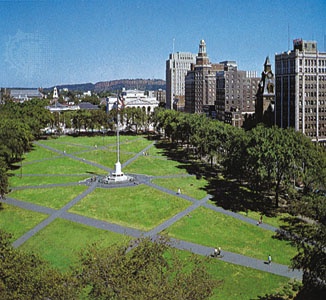New Haven
Connecticut, United States
 city, coextensive with the town (township) of New Haven, New Haven county, south-central Connecticut, U.S. It is a port on Long Island Sound at the Quinnipiac River mouth. Originally settled as Quinnipiac in 1638 by a company of English Puritans (Puritanism) led by John Davenport (Davenport, John) and Theophilus Eaton (Eaton, Theophilus), it was renamed in 1640, probably for Newhaven, England. In 1643 it combined with several adjacent towns, including Milford and Guilford, to form the New Haven colony, of which Eaton was governor until his death in 1658. In 1665 New Haven colony reluctantly accepted absorption into the more liberal and democratic Connecticut colony, which was based in Hartford and enjoyed a royal charter. From 1701 New Haven was co-capital with Hartford, a position it maintained in both colony and state until 1875. During the American Revolution it was sacked (July 5, 1779) by loyalist forces under Major General William Tryon. The town was an important centre of abolitionist sentiment during the American Civil War.
city, coextensive with the town (township) of New Haven, New Haven county, south-central Connecticut, U.S. It is a port on Long Island Sound at the Quinnipiac River mouth. Originally settled as Quinnipiac in 1638 by a company of English Puritans (Puritanism) led by John Davenport (Davenport, John) and Theophilus Eaton (Eaton, Theophilus), it was renamed in 1640, probably for Newhaven, England. In 1643 it combined with several adjacent towns, including Milford and Guilford, to form the New Haven colony, of which Eaton was governor until his death in 1658. In 1665 New Haven colony reluctantly accepted absorption into the more liberal and democratic Connecticut colony, which was based in Hartford and enjoyed a royal charter. From 1701 New Haven was co-capital with Hartford, a position it maintained in both colony and state until 1875. During the American Revolution it was sacked (July 5, 1779) by loyalist forces under Major General William Tryon. The town was an important centre of abolitionist sentiment during the American Civil War.New Haven's historical preeminence in many industrial fields is manifest in the number of inventions that first appeared in the area. These include Eli Whitney (Whitney, Eli)'s mass-production technique ( Hamden), Charles Goodyear (Goodyear, Charles)'s vulcanized rubber ( Naugatuck), Samuel Colt (Colt, Samuel)'s improved repeating revolver (Hamden), and sulfur matches (Woodbridge). The Winchester repeating rifle (the gun that “tamed the West”) was made in New Haven. Diversified manufacturing, educational services, and shipping are the modern economic mainstays. In 1957 New Haven was one of the first Eastern cities to undertake wholesale urban renewal of its decaying downtown area. Nonetheless, the neighbourhoods surrounding New Haven's downtown core remained run-down in the late 20th century and had such inner-city problems as unemployment, drugs, and crime.
New Haven is noted for its educational and cultural institutions. It is the seat of Yale University (founded 1701 and moved from Saybrook to New Haven in 1716), Southern Connecticut State University (1893), Albertus Magnus College (1925), and the New Haven campus of Gateway Community-Technical College (1992). Inc. city, 1784; town and city consolidated, 1895. Pop. (1990) city, 130,474; New Haven–Meriden PMSA, 530,180; (2000) city, 123,626; New Haven–Meriden PMSA, 542,149.
county, Connecticut, United States
county, south-central Connecticut, U.S. It is bordered to the south by Long Island Sound, to the southwest by the Housatonic River, and to the southeast by the Hammonasset River. The county's terrain consists of rolling plateaus and river valleys to the north and coastal lowlands to the south; the sound contains several islands. Other waterways include the Naugatuck, Quinnipiac, and Wepawaug rivers as well as Lakes Gaillard, Saltonstall, and Quassapaug. Parklands include Naugatuck State Forest Reserve and Sleeping Giant, West Rock Ridge, and Hammonasset Beach state parks.
English Puritans (Puritanism) founded New Haven colony in 1638, and it reluctantly joined Connecticut colony (1665) and became a county in 1666; county government was abolished in 1960. Initially dependent on agriculture and maritime trade, the economy became industrialized in the 19th century, spurred by the inventions of New Haven residents Eli Whitney (Whitney, Eli), who developed the concept of mass-producing interchangeable parts, and, later, Charles Goodyear (Goodyear, Charles), who created the vulcanization process for rubber. Manufacturing remains important, although services and trade have passed it in terms of value.
New Haven is the county's largest city and the seat of Yale University (founded 1701) and Southern Connecticut State University (founded 1893); from 1701 to 1875 it was co-capital of Connecticut, along with Hartford. The Naugatuck River valley supports heavy industry in Ansonia, Naugatuck, and Waterbury (the county's second largest city), which was once known as “Brass City” because it contained many brass mills. Guilford contains some 400 buildings from the 18th and 19th centuries, as well as the Henry Whitfield House (built 1639), the oldest stone house in New England. Other communities are Meriden, West Haven, Hamden, Milford, and Wallingford. The county is the cultural centre of the state, with numerous theatres and museums. Area 606 square miles (1,569 square km). Pop. (1990) 804,219; (1996 est.) 794,672.
- David Farragut
- David Foster Wallace
- David Friedrich Strauss
- David, Félicien-César
- David Garnett
- David Garrick
- David Gascoyne
- David George Hogarth
- David, Gerard
- David Grandison Fairchild
- David Günzburg, Baron
- David Hackett Souter
- David Halberstam
- David Halliday Moffat
- David Hartley
- David Hartley, the Younger
- David Hemery
- David Hendricks Bergey
- David Hilbert
- David H. Levy
- David Hockney
- David Hughes
- David Hume
- David Hunter
- David Hunter Hubel